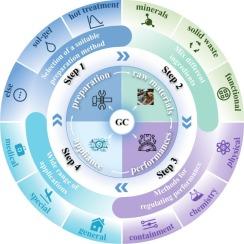微晶玻璃原料选择-性能调节-应用表达研究进展
IF 22
1区 材料科学
Q1 MATERIALS SCIENCE, MULTIDISCIPLINARY
引用次数: 0
摘要
微晶玻璃是一种功能材料,可以通过控制结晶从非晶态过渡到晶态。这些材料因其独特的微观结构和卓越的物理和化学性能而受到高度重视。基玻璃通常是通过淬火熔体,然后将其重新加热到特定温度来促进成核和结晶,通常在更高的温度下促进广泛的晶体生长来生产的。传统的制备方法包括熔融、烧结和溶胶-凝胶技术,但最近的进步引入了3D打印、热压和激光结晶等新方法。这些创新为特定形式的精密部件提供了更高效的制造选择。微晶玻璃的晶相和微观结构对其性能起着至关重要的作用,其中晶体尺寸、比例、结晶程度等因素尤为重要。这些都受晶体生长机制、结晶过程中的化学成分和热处理工艺的影响。即使少量添加稀有金属或过渡金属也会显著影响材料的性能,提高其在机械、光电和精密仪器中的性能。本文讨论了添加剂、性能调控和化学成分对微晶玻璃功能性能的影响,以及微晶玻璃的应用和未来潜力。本文章由计算机程序翻译,如有差异,请以英文原文为准。

Advances in glass-ceramics raw material selection-performance modulation-application expression: a review
Glass-ceramics are functional materials that transition from an amorphous to a crystalline state through controlled crystallization. These materials are highly valued for their unique microstructure and exceptional physical and chemical properties. The base glass is typically produced by quenching the melt and then reheating it to specific temperatures to promote nucleation and crystallization, often at elevated temperatures to encourage extensive crystal growth. Traditional preparation methods include melting, sintering, and sol–gel techniques, but recent advancements have introduced novel methods like 3D printing, hot pressing, and laser crystallization. These innovations offer more efficient fabrication options for precision components in specific forms. The crystal phase and microstructure of glass-ceramics play a critical role in determining their performance, with factors such as crystal size, proportion, and degree of crystallization being particularly important. These are influenced by both the crystal growth mechanisms and the chemical composition and heat treatment processes during crystallization. Even small additions of rare or transition metals can significantly impact the material’s properties, enhancing its performance in mechanical, optoelectronic, and precision instruments. This article discusses the impact of additives, performance regulation, and chemical composition on the functional properties of glass-ceramics, along with their applications and future potential.
求助全文
通过发布文献求助,成功后即可免费获取论文全文。
去求助
来源期刊

Materials Today
工程技术-材料科学:综合
CiteScore
36.30
自引率
1.20%
发文量
237
审稿时长
23 days
期刊介绍:
Materials Today is the leading journal in the Materials Today family, focusing on the latest and most impactful work in the materials science community. With a reputation for excellence in news and reviews, the journal has now expanded its coverage to include original research and aims to be at the forefront of the field.
We welcome comprehensive articles, short communications, and review articles from established leaders in the rapidly evolving fields of materials science and related disciplines. We strive to provide authors with rigorous peer review, fast publication, and maximum exposure for their work. While we only accept the most significant manuscripts, our speedy evaluation process ensures that there are no unnecessary publication delays.
 求助内容:
求助内容: 应助结果提醒方式:
应助结果提醒方式:


